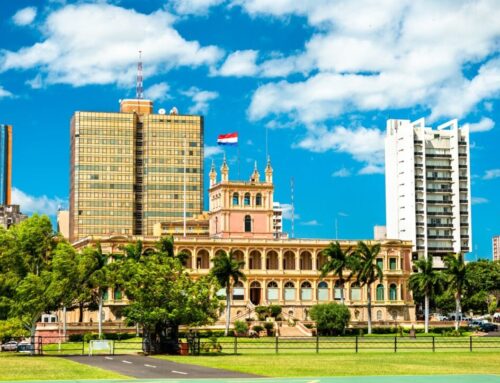Mitsubishi Power is Navigating the Path to Net Zero in a Volatile World
April 18, 2025

In a world increasingly affected by regional conflicts, political shifts, and extreme weather events, the global energy transition faces significant challenges. As power demand rises and the need for clean electricity grows, the energy sector must diversify sources and strengthen infrastructure. Industry leaders are discussing strategies to navigate these complexities, emphasizing the importance of renewable energy, hydrogen solutions, and equitable investment. By fostering global collaboration and innovation, a resilient, secure, and sustainable energy future can be built.
Regional Conflicts and Election Implications
Regional conflicts, election implications, and the growing frequency and intensity of extreme weather events are exposing the ever-changing uncertainties of the global energy transition. For the power sector, these issues complicate planning and investment in a clean energy future.
Rising to the Challenge
Industry can – and must – rise to the challenge. Energy leaders are exploring strategies for an increasingly complex world, highlighting the need to diversify energy sources and fortify infrastructure. Through global collaboration, disruptions can be adapted to ensuring a durable energy system.
Clear Path Forward
Despite the challenges, there’s a clear path forward. The International Energy Agency (IEA), in its annual World Energy Outlook, highlights actionable strategies to help industry leaders drive progress, instill confidence, and enhance resilience as they move toward net zero.
Meeting the Urgent Demand for Clean Electricity
Increasing Power Demand
Power demand is rising at an increasingly steep rate. According to the IEA report, “the equivalent of the electricity use of the world’s ten largest cities is being added to global demand each year.” Beyond the impact of AI and data centers on global server capacity, which is expected to more than double by 2030, the growing demand for electricity is also directly tied to the shift towards electric mobility. By 2030, the IEA’s Stated Policies Scenario (STEPS) predicts that one in two cars globally will be electric.
Accelerating Solutions
As the demand for clean electricity accelerates, so must the solutions. Renewables are pivotal to reducing reliance on energy sources like coal and achieving emissions targets. From 2023 to 2035, renewables are projected to meet nearly all growth in global electricity needs. However, their intermittent nature means they cannot lead the transition alone. As coal’s share in power generation is expected to drop from 36% in 2023 to 16% by 2035, natural gas is stepping in alongside renewables to ensure grid reliability and stability.
Hydrogen as a Solution
Hydrogen is also emerging as a critical solution to bridge the gap between reliability and clean energy. Mitsubishi Power is helping construct ACES Delta, a joint venture with Chevron. The groundbreaking project uses renewable energy to electrolyze water, producing up to 100 metric tons per day of green hydrogen. Stored in underground salt caverns, this hydrogen can be dispatched to power plants, providing clean, reliable energy to communities in the Western United States.
Expected to be one of the world’s largest hydrogen production and storage facilities, ACES Delta is designed to scale renewable solutions, which is essential to meeting the rising demand for clean and stable electricity.
Increasing Investment Through Innovation and Policy Moves
Investment Growth
According to the IEA, “since 2020, investment in clean energy technologies and infrastructure has increased by 60%,” and it must continue at this pace through public and private cooperation. Sufficient funding is essential to ensure that research and development drive innovation and enhance the reliability of energy systems, making them more resilient to future shocks.
Equitable Investment
Investment must also be more equitable. The IEA’s report highlights a significant disparity, with emerging markets and developing economies outside of China receiving only 15% of the total clean energy investment. Achieving global energy goals requires prioritizing all regions, not just the largest or most advanced.
To narrow these imbalances, policymakers, industry leaders, and stakeholders must work together to bridge these gaps and ensure no region is left behind.
Driving Security, Resilience, and Flexibility
Building a Secure Future
The choices made today will define the energy landscape for generations. A future that is secure, resilient, and adaptable to the needs of an interconnected, electrified world must be built.
Resilient and Reliable Energy
As the IEA warns, “without both resilient and reliable sources of energy and infrastructure to transport supply to customers, local or regional disruptions remain a distinct possibility in the face of risks from geopolitical tensions, technical failures, and extreme weather events.” These disruptions go beyond just power plants – they reach schools, stores, city halls, hospitals, and homes. Resilient power is vital for economic growth, technology advancement, and improved quality of life for all.
Ensuring Resilience Across the Supply Chain
Energy resilience spans the entire supply chain – from the moment infrastructure is built through its long-term use by power providers. Validating the importance of ensuring resilience across the supply chain, in the IEA’s Announced Pledges Scenario, annual investment in transmission and distribution grids is predicted to rise to $690 billion in 2030.
To ensure customers can rely on their equipment and that it will supply energy as intended, Mitsubishi Power operates advanced, hydrogen-fueled gas turbines at its validation power plant, testing and validating each turbine before delivery.
Once power solutions like these are deployed, Mitsubishi Power offers TOMONI, a digital platform that performs automated optimization of key equipment operating parameters, helping customers stay vigilant and proactively monitoring plants to optimize efficiency.
Ensuring Access to Energy for the Future
Acting Now for a Secure Future
The energy industry must act now to create a future that is secure, clean, and affordable. Power has a responsibility to drive the development of infrastructure to ensure energy security, accelerate clean energy adoption, and foster technological innovation. By engaging Mitsubishi in critical discussions on grid reliability, emissions management, low-carbon projects, and more, challenges can be navigated and a sustainable energy future that benefits everyone can be built through global collaboration, cutting-edge technology, and strategic investment.
To learn more about Mitsubishi Power’s innovative strategies and commitment to achieving net zero, visit their website and explore their comprehensive plans for a sustainable energy future.
Search
RECENT PRESS RELEASES
Related Post




